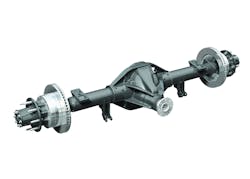Dana unveils new driveshaft, axle and tire pressure system
Dana Holding Corp. released a number of new products last week at the IAA Commercial Vehicle show in Hannover, Germany.
Designed for SUVs, medium-sized pickups and light commercial vehicles up to Class 6, the new Spicer formed aluminum tube driveshaft offers a single-piece assembly at reduced weight and increased clearance compared to a two-piece steel driveshaft, Dana said.
To be available in the U.S. by next summer, the driveshaft weights up to 25% less than two-piece steel assemblies while reducing cab noise and vibration. Built with a straight tube, the driveshaft is shaped to have an expanded center using a proprietary hydroforming manufacturing process. The expanded center allows it to run at higher speeds for a given length while offering increased strength and up to a 5% reduction in weight over straight aluminum tube driveshaft designs, Dana said.
“With more than a century of driveshaft innovations, Dana offers a complete range of technologically advanced products that provide industry-leading efficiency, reliability, and performance,” said Pat D’Eramo, president of Commercial Vehicle Drivetrain Technologies at Dana. “The Spicer formed aluminum tube driveshaft is the latest innovation from Dana to deliver the premium benefits demanded by buyers of light commercial vehicles.”
Dana also introduced the Spicer M300 axle featuring AdvanTek gearing. Available now in Salisbury style, the Class 1-5 M300’s AdvanTek gearing provides increased power density and efficiency in a smaller package than competitive axles, according to the company. Dana added that the wide gear face improves gearing strength, tapered roller bearings increase fuel efficiency by reducing friction in the axle, and the overall design is optimized for low NVH.
It is designed for use in light commercial vehicles with Gross Axle Weight Ratings of 11,500 to 16,000 lbs. and Gross Combined Weights of 40,000 lbs.
Also introduced in Germany was the company’s new tire pressure management technology for line-haul tractors. According to Dana, the fully integrated internal axle system is the first of its kind for commercial vehicles and is undergoing road testing at this point.
The system is electronically controlled and can improve fuel economy by 1% through periodic checks to ensure tires are at proper tire inflation and equalized tire pressure, Dana said.
“Proper tire maintenance is critical for fleet owners to maximize vehicle uptime and get the greatest return on their investments,” said D’Eramo. “This technology is uniquely designed to keep commercial-vehicle tractors out of the maintenance bay and on the road – operating at peak efficiency.”
The technology automatically initiates periodic system and pressure checks while driving. As needed, it inflates tires to the optimum pressure and can equalize pressure in all tractor tires, minimizing tire dragging and premature wear. A closed design isolates the tires, preventing a hose failure or tire puncture from affecting the other tires.
